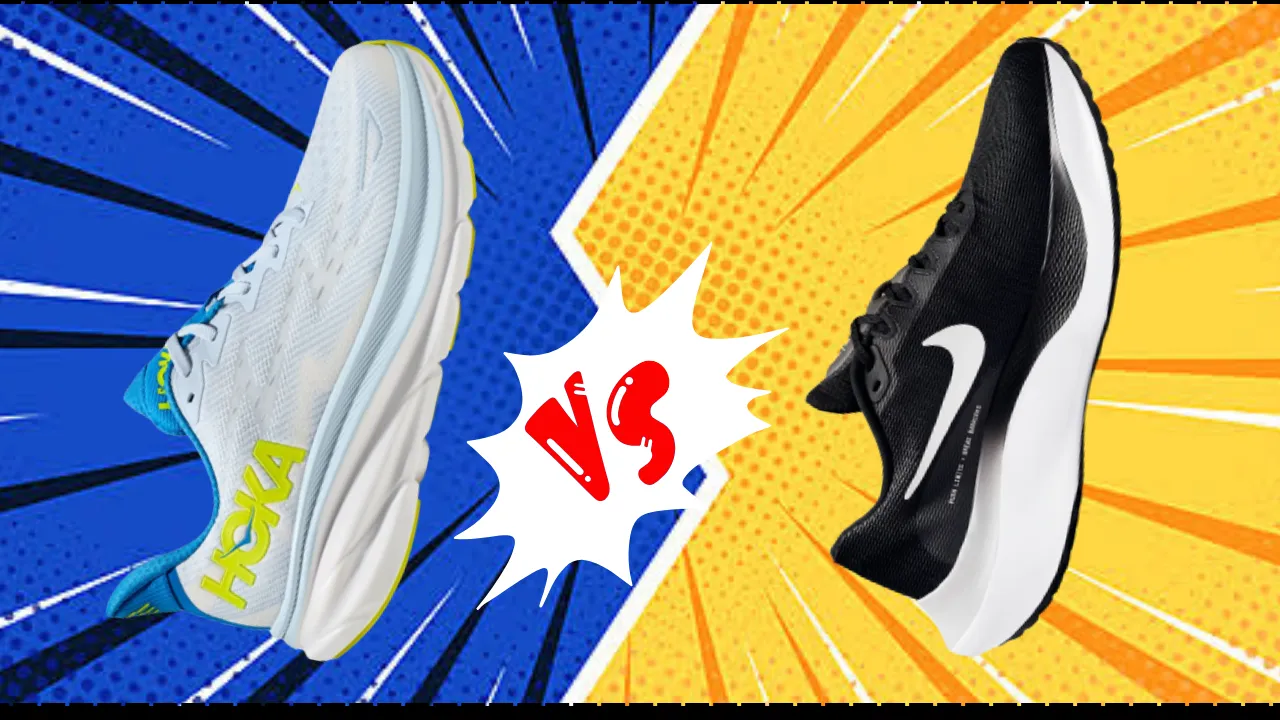If you’re looking for a cushioned daily training running shoe, two of the top options on the market are the Hoka Clifton 9 and the Nike Zoom Fly 5.
Both shoes provide soft cushioning and support for logging miles, but they differ when it comes to weight, flexibility, and intended use.
This in-depth comparison examines all the key features and performance of the Clifton 9 and Zoom Fly 5 to help you determine which is the better choice for your running needs. Keep reading to see how these popular shoes stack up.
Similarities And Differences Between Hoka Clifton 9 And Nike Zoom Fly 5:
| Feature | Hoka Clifton 9 | Nike Zoom Fly 5 |
|---|---|---|
| Launched In | 2023 | 2022 |
| Stability | Neutral | Neutral |
| Flexibility | Moderate | Moderate |
| Sizing | Men’s 7-13, Women’s 5-12 | Men’s 7-13, Women’s 5-12 |
| Weight | 8.8 oz (M), 7.5 oz (W) | 8.7 oz (M), 7.3 oz (W) |
| Cushion | High | High |
| Outsole | Durabrasion rubber | Nike React rubber |
| Midsole | CMEVA foam | Nike ZoomX foam |
| Upper | Engineered mesh | Engineered mesh |
| Retail Price | $145 | $155 |
Features Comparison:
Here we will see how Clifton 9 features perform against the Iconic Zoom Fly 5.
Materials
The Hoka Clifton 9 uses a CMEVA foam midsole to provide soft, resilient cushioning. The engineered mesh upper is highly breathable. On the outsole, Durabrasion rubber in high-wear areas boosts durability.


In contrast, the Nike Zoom Fly 5 relies on a full-length ZoomX foam midsole for responsive cushioning. Its upper is also an engineered mesh for ventilation. Nike’s React rubber on the outsole aims to deliver a smooth heel-to-toe transition.
Both shoes use lightweight foam cushioning systems, but the ZoomX foam in the Nike option is known for its energy return.
The mesh uppers are comparable in providing a comfortable fit, but testers found the Hoka’s upper runs a bit narrow. For outsole durability, Nike’s React rubber has similar longevity to Hoka’s Durabrasion rubber.
Durability
In terms of durability, the Hoka Clifton 9 tends to last around 300-500 miles before signs of wear appear.
The CMEVA foam retains cushioning well through moderate mileage. High abrasion areas of the outsole show minimal breakdown over the shoe’s lifespan. Though the engineered mesh upper is breathable, it is also durable and resists ripping or tearing.
For the Nike Zoom Fly 5, testers can get over 400 miles out of the shoe before a noticeable decrease in performance.
The full-length ZoomX foam is long-lasting and does not flatten easily, maintaining responsiveness. The React rubber outsole also withstands abrasion on varied surfaces. Much like the Hoka, the upper holds up well without compromising its structure.
Overall, both shoes are built to be durable daily trainers. The Nike may have slightly greater longevity, but both can go several hundred miles before retiring.
Fit
The Hoka Clifton 9 runs narrowly through the midfoot and toe box, which can pinch wider feet.
Testers recommend sizing up half a size for a more comfortable fit. The engineered mesh upper hugs the foot securely from heel to toe. Though breathable, it does not have much stretch. A thicker padded ankle collar cushions the Achilles area.


In the Nike Zoom Fly 5, the upper provides a snug midfoot wrap while allowing room to splay toes. The flat, wide laces help customize the fit. Testers found sizing true to length is fine for most foot shapes. The toe box has a tapered profile but avoids being overly restrictive on natural toe spread.
When it comes to fit, the Nike is better suited for wide-footed runners who want a secure but not too tight upper. Those with narrow to average feet can consider the Hoka with sizing up.
Stability
With its neutral platform, the Hoka Clifton 9 provides inherent stability for most runners without pronation control features.
The CMEVA foam midsole is not overly soft, giving a stable base for foot strikes and toe-offs. A moderate heel-to-toe offset (5mm) encourages a smooth transition through the gait cycle. The upper offers a snug, crease-free fit around the midfoot to keep feet centered over the sole unit.
In the Nike Zoom Fly 5, the wide base of the ZoomX foam midsole enhances stability at moderate paces. The upper also securely wraps the midfoot to support neutral gaits. The midsole is not so high off the ground as to feel tippy.
Additionally, the 8mm offset promotes an aligned gait cycle. In summary, both shoes suit neutral runners looking for a stable yet flexible platform. The Hoka leans more towards a natural foot positioning while the Nike has inherent stability from its wide platform.
Cushioning
Known for its maximally cushioned rides, the Hoka Clifton line includes the same soft CMEVA foam as prior versions. The full-length midsole provides plush cushioning that absorbs impact shock with each stride. The rockered profile encourages smooth heel-to-toe transitions. Rides are best suited for easy paces where runners can appreciate the marshmallow-like softness.
In the Zoom Fly 5, Nike uses a full-length ZoomX foam platform to deliver responsive, springy cushioning. It has ample shock absorption for longer distances but also provides energy return for a propulsive toe-off. The foam does not compact down over time like EVA blends.
However, the ZoomX midsole feels firmer than Clifton’s CMEVA foam. For those seeking the most cushioned, pillowy soft ride, the Hoka Clifton 9 delivers plush comfort better than the Nike. But the Zoom Fly 5 balances cushioning with feedback.
Value
At its $145 price point, the Clifton 9 delivers exceptional value for those wanting a well-cushioned trainer. Comparable shoes from other max-cushion brands cost $10 to $30 more while offering similar underfoot comfort.
The durable CMEVA foam and breathable upper make the shoe suitable for daily miles. Relative to its premium comfort, the price is budget-friendly.
The Nike Zoom Fly 5 costs $155, putting it on the pricier end of daily trainers. However, testers found the responsive ZoomX foam and React rubber outsole merit the higher cost over foam-based options. As a durable shoe equipped for long distances, the value matches the price point.
When choosing, runners on a tighter budget can opt for the Clifton 9 to maximize comfort per dollar spent. But the Zoom Fly 5 is a reasonable value for its versatile cushioning and secure lockdown.
Performance Comparison:
In this section we will compare the performance of Zoom Fly 5 and Clifton 9 to see who excels at daily tasks.
Walking
The Hoka Clifton 9 has an ultra-cushioned midsole that feels plush and comfortable when walking. The rockered shape makes heel-to-toe transitions very smooth.
The thicker foam also absorbs impact from hard surfaces. The upper is breathable and flexible enough for the forward bend of walking strides.
In the Nike Zoom Fly 5, the firm ZoomX foam midsole has good shock absorption for walking but lacks the plush feel of the Clifton 9. The upper bends well with the foot for a natural stride.
For pure walking comfort, the extra foam cushioning of the Clifton 9 has an advantage over the Zoom Fly 5. But both provide adequate support and flexion for long walks.
Running
Designed for easy runs, the Hoka Clifton 9 excels at moderate paces up to around 9 min/mile where runners can enjoy the high cushioning.
The rocker midsole facilitates forward motion to make slower miles feel smooth and low impact. However, the cushioning bottoms out when pushed to faster speeds.
The Nike Zoom Fly 5 has responsive ZoomX foam tuned better for a wider range of paces, from easy to tempo runs. There is enough protection for longer miles but also energy return for a propulsive toe-off at faster paces above 7 min/mile.
For strictly slow runs, the Clifton 9 has the edge. But the Zoom Fly 5 is the more versatile option for runners who vary their speeds.
Plantar Fasciitis
The Hoka Clifton 9’s soft CMEVA foam cushioning absorbs pressure on the heels and arches to relieve pain from plantar fasciitis. The Meta-Rocker shape encourages a smooth stride from heel strike through toe-off, minimizing strain on the plantar fascia ligament.
In the Nike Zoom Fly 5, the ZoomX foam has ample shock absorption but is firmer than the Clifton 9. However, the rockered shape still facilitates heel-to-toe transitions to reduce tension on the arches.
For the highest level of cushioning, the plush Clifton 9 is best for plantar fasciitis and heel pain. But the Zoom Fly 5 also adequately attenuates shock.
Standing All Day
The Hoka Clifton 9 provides exceptional cushioning and support for standing all day. The soft CMEVA foam reduces fatigue in the feet and legs compared to firmer shoes.
The upper hugs the midfoot securely while having a roomy toe box to avoid compression.
In the Nike Zoom Fly 5, the ZoomX foam is also comfortable for extended standing but not quite as soft as the Clifton 9. However, the wide base feels stable on hard floors.
Overall, the Clifton 9 is the superior choice for standing all day due to its plush cushioning. But the Zoom Fly 5 has adequate comfort and support for lengthy-standing as well.
Final Verdict:
In comparing the Hoka Clifton 9 and Nike Zoom Fly 5, the main differences come down to the cushioning and versatility.
The Clifton 9’s plush CMEVA foam provides a softer, more pillowy ride preferred by runners who like high cushioning for easy miles and recovery days. It also has the advantage of walking comfort and relieving foot pain. However, the narrow fit may not work for wide-footed runners.
In contrast, the Zoom Fly 5 has a firmer ZoomX foam midsole tuned for a wider range of paces. It offers a more responsive ride and stable platform appealing to neutral runners who vary their speeds.
Ultimately, the choice comes down to your specific needs and preferences. The Clifton 9 is best for pure cushioning comfort at easy paces. The Zoom Fly 5 is the more versatile option if you plan to run tempos and workouts along with slower runs.
Whether you want a soft and smooth ride (Clifton 9) or a responsive and stable shoe (Zoom Fly 5) can help you decide which trainer is the right match for you. Both provide quality cushioning, support, and durability making them suitable options for high-mileage neutral runners.

